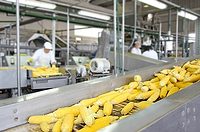Automated Washing of Totes, Buggies and Containers Plays a Critical Role in Food Processing
Hygiene mandates in food production and packaging facilities continue to be a critical focus of processors and regulators, yet some companies still cling to cumbersome and less-than-effective methods of washing and sanitizing containers used in the process stream.
Although existing regulations may not mandate a specific level or methodology of cleaning and sanitizing, there are hygiene and efficiency related reasons that food processors should pay more attention to this process.
In hand washing operations, including power spraying, there is much room for human error. Workers may not achieve the water temperature required to properly sanitize containers. Even after hand washing, food remnants and cleaning agent residue can remain in the seams and corners of containers put back into use.
By automating the washing process, however, food processors are assured a complete cleaning and sanitizing of containers every time.
There are also other benefits that add to the strong economic case for integrating automated washing systems. For example, saving on wasted labor and floor space and improving on production throughput are important incentives for many food processors.
“Washing systems are becoming an integral part of the food processing line,” says Mark Corser, president of CM Process Solutions (Corona, CA), a nationwide supplier of stainless steel hygiene equipment, including commercial and industrial washing systems, for the food processing, pharmaceutical and distribution industries.
“Instead of manually washing containers with a hose or pressure washer, which introduces risk into the process, more companies are installing systems that automatically meet its specific washing and sanitizing needs, and are also adding to their volume capacity as well,” Corser explains. “This approach ultimately impacts product quality.”
Better Pizza
Papa John’s, the world’s third-largest pizza chain, attributes much of its success to using better ingredients to make better pizza. One of the key ingredients, of course, is the pizza dough, which Papa John’s management insists will always be fresh. Thus, every day thousands of trays of fresh pizza dough are sent out from the company’s distribution commissaries to stores all over the world.
The use of fresh dough is a bit more challenging than handling frozen dough, which is used by many of Papa John’s competitors. For one thing, fresh dough is much “stickier” than its frozen counterpart, causing some residue left in many of the dough trays after use. This makes it very important that every one of the legions of trays is thoroughly washed and completely dried before they are reloaded with fresh dough for further distribution.
 To help meet this stringent requirement, Papa John’s Dallas TX commissary installed an automated two lane, four tank washing system provided by CM Process Solutions to clean and sanitize its dough trays at the rate of 2,000 per hour.
To help meet this stringent requirement, Papa John’s Dallas TX commissary installed an automated two lane, four tank washing system provided by CM Process Solutions to clean and sanitize its dough trays at the rate of 2,000 per hour.
“This washing system plays a vital in the process,” says Dan Farmer of Papa John’s U.S. Corporate Engineering QCC Operations. “The rapid and more or less continuous washing and drying of these trays allows us to automatically meet our volume requirements and ensure consistent cleanliness.”
“However, the real key was ensuring the trays were totally bone dry as they were conveyed from the washer directly to the production area for immediate re-use and CM Process Solutions guaranteed this and delivered it,” adds Farmer.
In addition to the assurance that the automated washing system will meet Papa John’s stringent hygiene standards, Farmer adds that a properly designed automated washing system also pays off in tray throughput at Papa Johns.
“The equipment we selected was priced competitively, met our quality standards, and was also tailored to fit our processing line so that we are easily able to meet the necessary tray cleaning production rate for the commissary operation.”
Farmer adds that this type of washing system has become the standard throughout Papa John commissaries, and that his organization has just placed an order for two new systems for delivery this year.
Bathing Buggies
In Northern California, Laura Chenel’s Chevre, an award-winning American pioneer of goat cheese processing, recently installed a customized washer from CM Process Solutions to clean and sanitize its process buggies used to transfer cheese from the mixer to the packaging department at its newly expanded Sonoma County plant.
 “These buggies handle millions of pounds of cheese annually,” explains Charles Willard, senior project engineer. “This is still done in small batches, 400 lbs. at a time, so these buggies are an integral part of the process stream. Once the cheese has been processed, the buggies must be cleaned and made ready for the next cycle.”
“These buggies handle millions of pounds of cheese annually,” explains Charles Willard, senior project engineer. “This is still done in small batches, 400 lbs. at a time, so these buggies are an integral part of the process stream. Once the cheese has been processed, the buggies must be cleaned and made ready for the next cycle.”
Prior to opening the new facility, workers used to clean the buggies with spray hoses in an open area of the plant, which didn’t have much floor space.
“Before, this was a fulltime job,” Willard explains. “But since we got the automated washing system, we simply line up the carts and push them in and start the system. Because it is automated, the worker in charge of cleaning the buggies can do other things while the washer is working. It saves on labor for spray washing and does a much better cleaning job.”
According to Willard, the construction standards used to manufacture the washing equipment were critical as well. “We evaluated the system by the type of construction, such as the stainless steel, the quality of the welds, and the use of metal parts instead of plastic parts, as well as overall engineering and durability.”
He specifically was impressed with the level of detail in sanitation that CM Process Solutions took into consideration.
“One important design element is that the buggies are front-loaded into the washer upside down to ensure that even the wheels are completely cleaned,” says Willard. “Other washing systems load the buggy in on its side with the wheels facing the front door where there are no spray nozzles. This means the wheels are not cleaned well and we didn’t want to risk tracking contaminants from the back end of the process to the front, where the cheese is loaded.”
Both Willard and Farmer point out that, in addition to system configuration, there are other parameters that must be customized to provide the right washing system solution for a specific application. This includes water temperature, cleaning agents and water recovery systems, all of which can be vital to meeting both food safety and productivity goals.
For example, the choice of heating options—whether gas, steam coils, live steam injection or electric—could be vital to an application. The optimal washing system design also must take into consideration the quantity of items to be washed and the level of soiling, rinsing and drying requirements. Even speed of throughput should match the application, whether the requirement is a batch cleaning process with individual containers or a more advanced, continuous, multi-lane system.
For more information, contact CM Process Solutions, 1269 Pomona Road, Corona, CA 92882; Phone: (951) 808-4376; Fax: (951) 808-8657; Email: sales@cmpsolutions.net or visit the website: www.cmpsolutions.net.
Looking for a reprint of this article?
From high-res PDFs to custom plaques, order your copy today!




